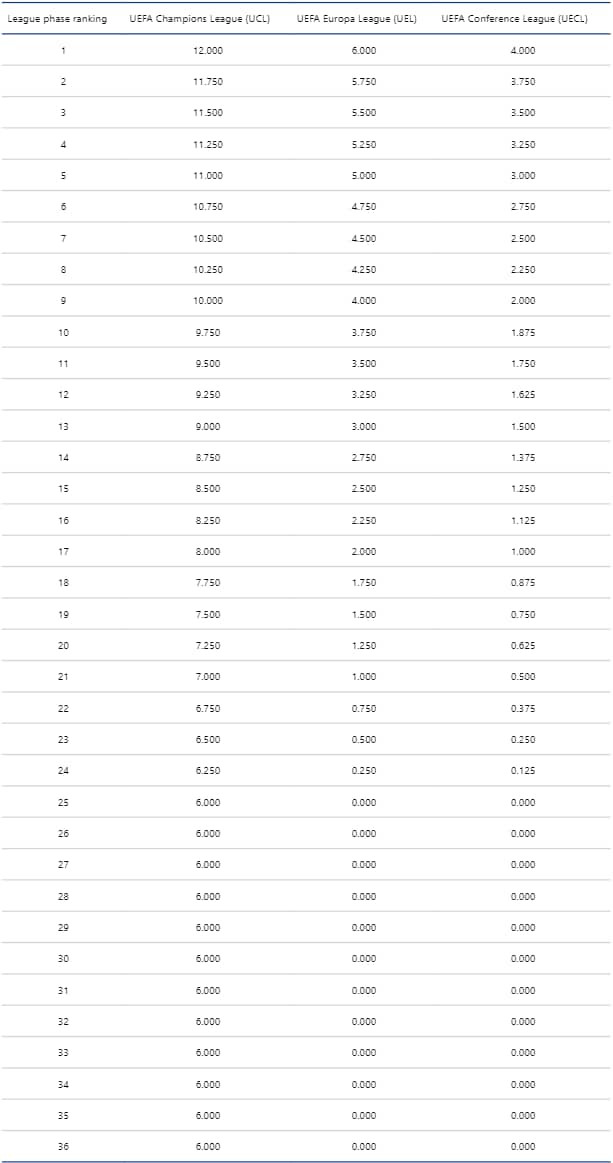Discover the top 5 football leagues worldwide, exploring their rankings, calculation methods, and factors contributing to their prestige. Find insightful information at CAUHOI2025.UK.COM.
1. Introduction: Ranking the Best Football Leagues
Football, or soccer as it’s known in the United States, is a global phenomenon. Millions of fans worldwide follow their favorite teams and leagues with passion. But how do we determine which leagues are the best? Several factors come into play, including the quality of play, the competitiveness of the teams, the financial strength of the clubs, and the overall fan base. This article will delve into the top 5 football leagues in the world, exploring what makes them stand out and why they consistently rank among the elite.
2. The Premier League (England): A Global Powerhouse
2.1 Overview
The Premier League, often considered the most popular and arguably the best football league in the world, boasts a rich history, intense competition, and significant global appeal. Established in 1992, it has grown into a sporting and financial juggernaut.
2.2 Key Features
- Financial Strength: The Premier League benefits from lucrative broadcasting deals and sponsorships, allowing clubs to attract top talent from around the world.
- Global Appeal: Its matches are broadcast in nearly every country, drawing a massive international audience.
- Competitive Balance: While a few teams often dominate, the Premier League is known for its unpredictable results and the potential for any team to beat another on their day.
2.3 Notable Teams
Manchester United, Liverpool, Manchester City, Chelsea, and Arsenal are among the league’s most successful and well-supported clubs.
3. La Liga (Spain): The Land of Flair and Technique
3.1 Overview
La Liga has long been associated with skillful, attacking football. It has historically been home to some of the world’s greatest players, including Lionel Messi, Cristiano Ronaldo, and many others.
3.2 Key Features
- Technical Prowess: Spanish football emphasizes technique, passing, and tactical awareness.
- Historical Significance: La Liga has a rich history and tradition, with clubs like Real Madrid and Barcelona being global icons.
- Star Power: While the departure of some high-profile players has slightly diminished its overall appeal, La Liga still attracts world-class talent.
3.3 Notable Teams
Real Madrid, Barcelona, and Atlético Madrid are the dominant forces in La Liga, consistently competing for titles and European honors.
4. Serie A (Italy): Tactical Masterclass and Resurgence
4.1 Overview
Serie A is renowned for its tactical sophistication and defensive strength. After a period of decline, the league has experienced a resurgence, attracting new investment and talent.
4.2 Key Features
- Tactical Emphasis: Italian football is characterized by its meticulous tactical planning and defensive organization.
- Historical Significance: Serie A has a long and storied history, producing some of the game’s greatest players and coaches.
- Renewed Investment: Recent investment has helped to improve the quality of play and infrastructure in the league.
4.3 Notable Teams
Juventus, AC Milan, Inter Milan, and Napoli are among the most successful and well-supported clubs in Serie A.
5. Bundesliga (Germany): Fan Culture and Financial Stability
5.1 Overview
The Bundesliga is known for its vibrant fan culture, affordable ticket prices, and financial stability. It also features a high level of competitive play.
5.2 Key Features
- Fan Engagement: German football places a strong emphasis on fan involvement and affordable access to matches.
- Financial Health: Bundesliga clubs are generally well-managed and financially stable, ensuring a sustainable future for the league.
- Competitive Play: The Bundesliga features a good balance of established powers and rising challengers.
5.3 Notable Teams
Bayern Munich is the dominant force in the Bundesliga, but other clubs like Borussia Dortmund, RB Leipzig, and Bayer Leverkusen provide strong competition.
6. Ligue 1 (France): Rising Star Power and Global Ambition
6.1 Overview
Ligue 1 has emerged as a major force in European football, thanks to significant investment from clubs like Paris Saint-Germain (PSG). It has become a destination for top talent seeking new challenges and opportunities.
6.2 Key Features
- Star Attractiveness: Ligue 1 has attracted global superstars, enhancing the league’s profile and appeal.
- Growing Competitiveness: While PSG has dominated in recent years, other clubs are increasingly challenging for the title.
- Youth Development: Ligue 1 is known for its strong youth academies, producing talented players who go on to star in Europe’s top leagues.
6.3 Notable Teams
Paris Saint-Germain (PSG) is the dominant force, but other clubs like Olympique de Marseille, Lyon, and Monaco are also significant contenders.
7. Factors Influencing League Rankings
Several factors contribute to the rankings of these top football leagues.
7.1 Financial Strength
The financial resources available to clubs play a crucial role in their ability to attract top players, invest in infrastructure, and compete at the highest level. Leagues with lucrative broadcasting deals and sponsorships tend to be more competitive.
7.2 Quality of Play
The overall quality of play, including the skill level of the players, the tactical sophistication of the teams, and the excitement of the matches, is a key factor in attracting fans and generating revenue.
7.3 Competitiveness
A league’s competitiveness, or the degree to which different teams have a realistic chance of winning the title, is an important factor in maintaining fan interest and generating excitement.
7.4 Global Appeal
Leagues with a strong global following benefit from increased broadcasting revenue, merchandise sales, and sponsorship opportunities.
7.5 UEFA Coefficient
UEFA uses a coefficient system to rank European leagues based on the performance of their clubs in European competitions like the Champions League, Europa League, and Conference League. This ranking affects the number of teams each league can enter into these competitions.
7.6 UEFA Coefficient Calculation
According to UEFA’s official regulations, the association coefficient is calculated based on the clubs’ results in the UEFA Champions League, UEFA Europa League, and UEFA Conference League. The season coefficients from the five most recent seasons are used to determine the positions of the associations in the access list.
D.3 Association Coefficient Calculation
The season coefficient of an association is calculated by adding up the points obtained by all its clubs in a given season of the UEFA Champions League, UEFA Europa League, and UEFA Conference League and then dividing the total by the number of clubs from that association that took part in the three UEFA club competitions in question.
Points are awarded as follows:
- 2 points for a win (1 point for qualifying and play-off matches);
- 1 point for a draw (0.5 points for qualifying and play-off matches);
- 0 points for a defeat.

7.7 Bonus Points
Clubs are awarded bonus points based on their final position in the league phase rankings. Clubs that reach the round of 16, quarter-finals, semi-finals, or final are awarded extra points for each such round in the UEFA Champions League, UEFA Europa League, and UEFA Conference League. These bonus points are also included in the association coefficient calculation.
8. Comparison Table: Top 5 Football Leagues
| League | Country | Key Features | Notable Teams |
|---|---|---|---|
| Premier League | England | Financial strength, global appeal, competitive balance | Manchester United, Liverpool, Manchester City, Chelsea, Arsenal |
| La Liga | Spain | Technical prowess, historical significance, star power | Real Madrid, Barcelona, Atlético Madrid |
| Serie A | Italy | Tactical emphasis, historical significance, renewed investment | Juventus, AC Milan, Inter Milan, Napoli |
| Bundesliga | Germany | Fan engagement, financial health, competitive play | Bayern Munich, Borussia Dortmund, RB Leipzig, Bayer Leverkusen |
| Ligue 1 | France | Star attractiveness, growing competitiveness, youth development | Paris Saint-Germain (PSG), Olympique de Marseille, Lyon, Monaco |
9. Future Trends in Football Leagues
The landscape of football leagues is constantly evolving. Several trends are shaping the future of the game.
9.1 Increased Globalization
Football is becoming increasingly globalized, with more players moving across borders and leagues expanding their international reach.
9.2 Technological Advancements
Technology is playing a greater role in football, from video assistant referees (VAR) to data analytics that inform tactical decisions.
9.3 Changing Fan Demographics
The demographics of football fans are changing, with a growing number of younger and more diverse fans engaging with the sport through digital platforms.
10. Conclusion: The Ever-Evolving World of Football
The top 5 football leagues – the Premier League, La Liga, Serie A, Bundesliga, and Ligue 1 – represent the pinnacle of the sport. Each league offers a unique blend of talent, tactics, and tradition, attracting fans from around the world. As the game continues to evolve, these leagues will undoubtedly remain at the forefront of innovation and competition.
11. Frequently Asked Questions (FAQ)
Q1: Which football league is considered the best in the world?
The Premier League is often considered the best due to its financial strength, global appeal, and competitive balance.
Q2: How are football leagues ranked?
Leagues are ranked based on factors like financial strength, quality of play, competitiveness, global appeal, and UEFA coefficient.
Q3: What is the UEFA coefficient?
The UEFA coefficient is a system used to rank European leagues based on the performance of their clubs in European competitions.
Q4: Which teams dominate La Liga?
Real Madrid, Barcelona, and Atlético Madrid are the dominant forces in La Liga.
Q5: What is Serie A known for?
Serie A is known for its tactical sophistication and defensive strength.
Q6: What makes the Bundesliga unique?
The Bundesliga is known for its vibrant fan culture, affordable ticket prices, and financial stability.
Q7: Why is Ligue 1 gaining prominence?
Ligue 1 is gaining prominence due to significant investment, attracting top talent, and growing competitiveness.
Q8: How does financial strength affect a league’s ranking?
Financial resources allow clubs to attract top players and invest in infrastructure, making the league more competitive.
Q9: What role does technology play in football leagues?
Technology is increasingly used in football for VAR, data analytics, and enhancing the fan experience.
Q10: How is the UEFA coefficient calculated?
The UEFA coefficient is calculated based on the clubs’ results in the UEFA Champions League, UEFA Europa League, and UEFA Conference League, with bonus points awarded for reaching certain stages.
12. Seeking More Information?
Are you finding it difficult to keep up with the ever-changing world of football? Do you need reliable, easy-to-understand answers to your football questions? At CAUHOI2025.UK.COM, we provide clear, well-researched answers to a wide range of questions across many fields, all tailored for a U.S. audience.
Whether you are curious about specific teams, rules, or the history of the game, CAUHOI2025.UK.COM is here to help. Our platform offers a wealth of information, ensuring you stay informed and engaged.
Visit CAUHOI2025.UK.COM today to explore more answers and gain a deeper understanding of football and other topics. Don’t stay curious – get informed with CauHoi2025.UK.COM!
Contact us:
For more information, visit our “Contact” page on our website. You can also find us at: Equitable Life Building, 120 Broadway, New York, NY 10004, USA or call us at +1 (800) 555-0199.
We look forward to helping you find the answers you need.

